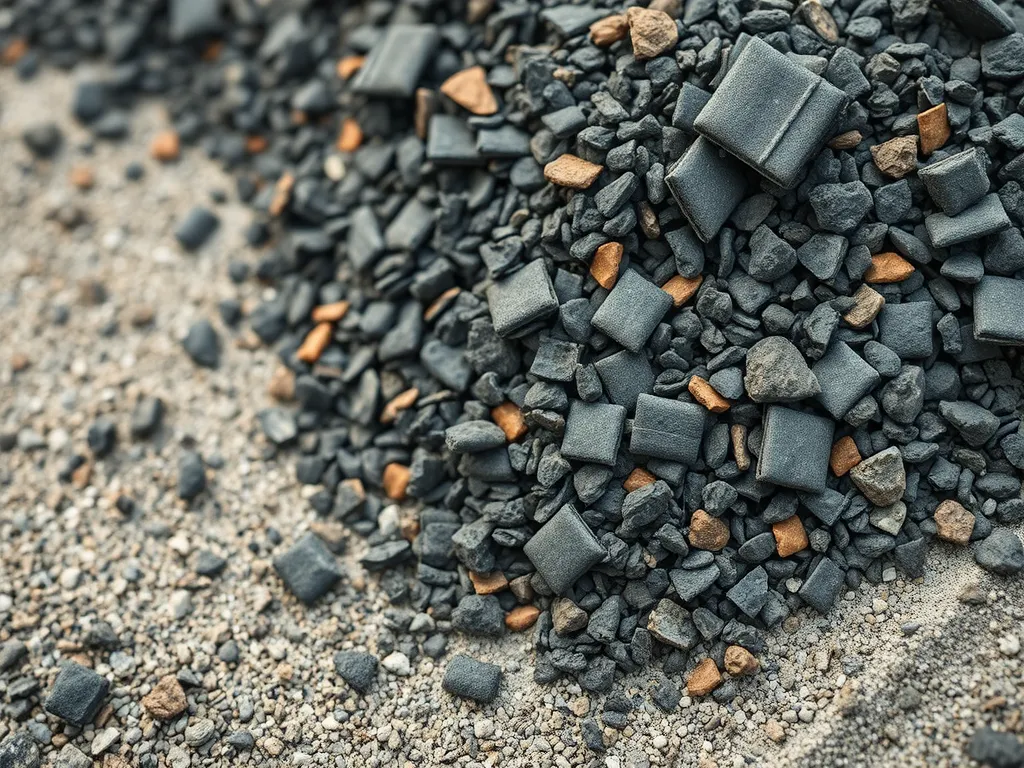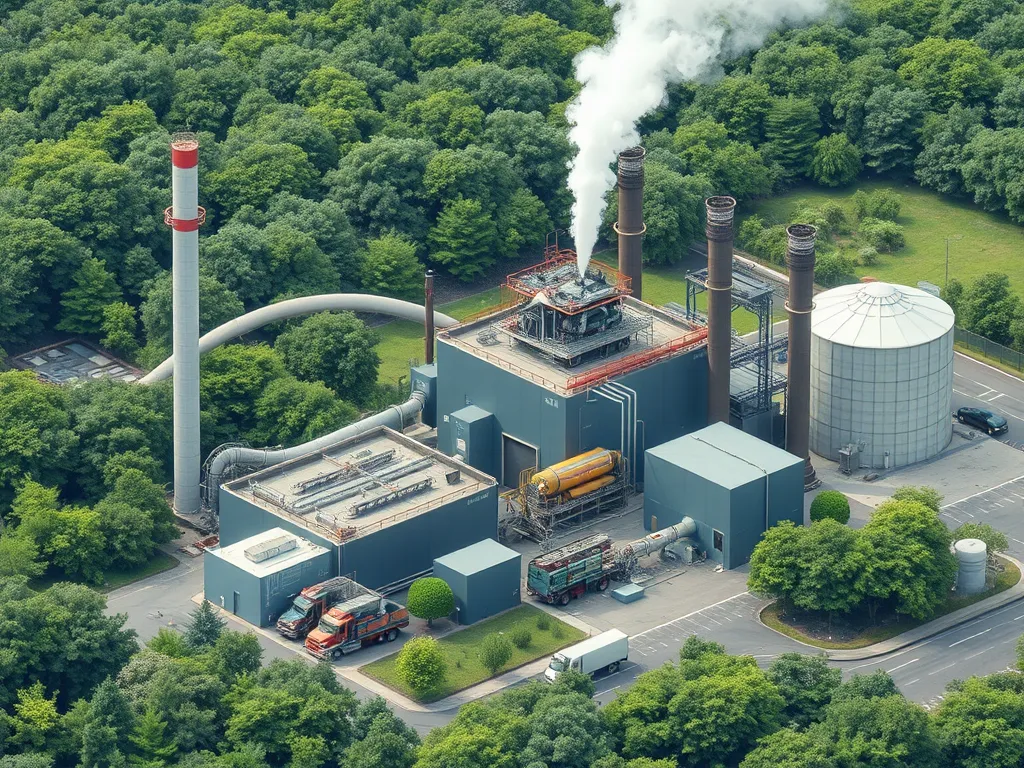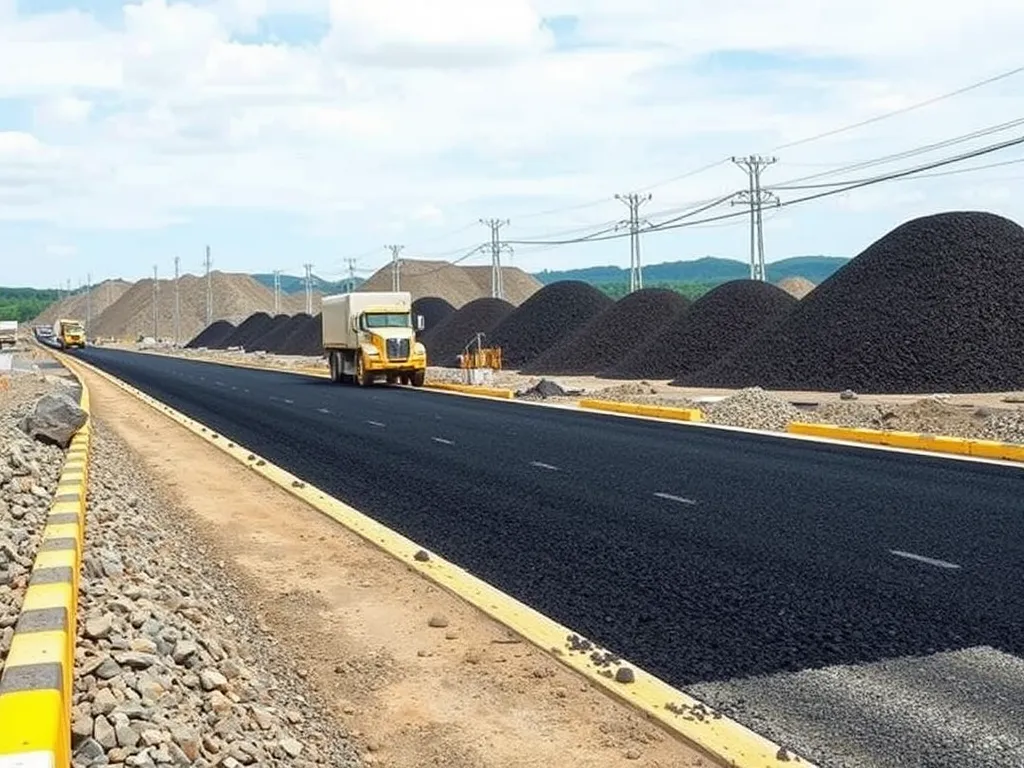Asphalt Waste Management Strategies: Turning Trash Into Treasure for Better Roads
Published on: August 16, 2025 | Last Updated: April 14, 2025
Written By: George Voss
Asphalt waste management strategies are systems to recycle, reuse, or dispose of old pavement materials safely. These methods keep 90 million tons of asphalt out of U.S. landfills yearly while cutting new construction costs by 20-30%. Key approaches include cold recycling, thermal processing, and blending reclaimed asphalt pavement (RAP) into fresh mixes. They address environmental risks like groundwater contamination, align with EPA guidelines, and reduce reliance on virgin aggregates and bitumen.
This guide explores how to handle asphalt waste from roads, roofs, and industrial sites. Learn about hot and cold recycling techniques, regulations like RCRA Subtitle D, and cost-saving reuse methods. Get data on carbon footprint reduction, case studies from highway projects, and tips for documentation. We break down landfill alternatives, RAP grading standards, and how recycled asphalt shingles (RAS) boost sustainability.
Contents
- Introduction to Asphalt Waste Management
- Understanding Asphalt Waste Materials
- Asphalt Waste Disposal Methods
- Asphalt Recycling Strategies
- Waste Management Approaches for Asphalt
- Regulatory Compliance in Asphalt Management
- Cost-benefit Analysis Of Asphalt Recycling
- Impact and Sustainability
- Case Studies in Asphalt Waste Management
- Frequently Asked Questions (FAQ)
- Closing Thoughts
- Additional Resources for You:
Introduction to Asphalt Waste Management
Asphalt waste management is the plan to handle old road stuff. It aims to cut waste, save cash, and shield the earth. Main ways? Reuse, recycle, or safe toss. Each ton reused saves $30-$50. Green rules now push for 90% reuse in road jobs.
Key parts: track where waste comes from (roads, roofs, plants), sort it right, pick the best process. Cold recycle blends old mix with new binder. Hot melt needs heat. Both slash need for new stuff by half.
Good plans track each step. Use tech to sort and test. Keep records for green checks. This cuts risk of fines and lifts rep.
To grasp the full scope, first see what makes up asphalt waste and where it comes from.
Understanding Asphalt Waste Materials
Effective asphalt waste management starts with knowing what materials you’re dealing with. Asphalt waste isn’t just rubble – it’s a blend of aggregates, bitumen, and additives that can be repurposed or recycled. Identifying its composition dictates the right strategy for handling it.
What Happens to Waste Asphalt?
Waste asphalt follows two paths: recycling or regulated disposal. Over 95% of reclaimed asphalt pavement (RAP) gets recycled into new roads, parking lots, or driveways. The remaining 5% enters landfills when contaminated with chemicals, oils, or non-recyclable debris. Some states allow processed asphalt chunks as base material for temporary roads or erosion control.
Recycling plants crush RAP into ½-inch minus granules for reuse. Advanced facilities use infrared heaters to soften aged asphalt for patching. Non-recyclable waste undergoes thermal processing at 300°F–400°F to extract residual bitumen before disposal.
Primary Sources Of Asphalt Waste
Four sectors generate most asphalt waste:
- Road Projects: Milling during resurfacing creates 90 million tons of RAP annually in the U.S.
- Roofing Shingles: Tear-offs contribute 11 million tons of asphalt shingle waste yearly, containing 20%–30% reusable bitumen.
- Manufacturing Scrap: Plants discard 2%–5% of batches due to temperature errors or mix design flaws.
- Construction Debris: Broken pavement from site prep, utility cuts, or demolition adds 7 million tons to landfills.
With asphalt waste materials identified, the next step is choosing disposal methods that balance cost, regulations, and environmental impact.

Asphalt Waste Disposal Methods
Proper asphalt waste management balances environmental care with practical solutions. While landfills remain an option, modern strategies prioritize methods that cut costs and reduce ecological harm. Let’s break down the most effective ways to handle discarded asphalt materials.
Best Practices for Asphalt Disposal
Effective disposal starts with planning. Segregate asphalt from other debris like concrete or wood to maintain purity. Test materials for contaminants such as coal tar or petroleum residues before processing. Partner with certified recycling facilities to ensure compliance with EPA guidelines. Always check state-specific rules—some regions ban asphalt from landfills entirely.
Four Core Disposal Practices
Four methods dominate asphalt waste strategies today. Each approach offers unique benefits for different project scales and budgets.
Landfill Diversion
Diverting asphalt from landfills slashes disposal fees and environmental strain. Over 90% of asphalt can be reused or recycled. Many states offer tax breaks for companies achieving 75%+ diversion rates. Partner with local recyclers to turn waste into RAP (Reclaimed Asphalt Pavement) for future projects. This method also earns LEED credits for sustainable construction.
On-Site Reuse
Crush and repurpose asphalt directly at the project site. A portable crusher can process 100-500 tons daily, creating base material for new roads or parking lots. On-site reuse eliminates hauling costs, which average $25-$50 per ton. Use processed chunks as temporary road fill or erosion control barriers during construction.
Thermal Processing
High heat breaks down old asphalt into reusable components. Pyrolysis—a process heating materials to 300-400°C—recovers 95% of bitumen binders. Gasification converts waste into syngas for energy production. These methods handle contaminated asphalt that can’t be cold-recycled, though they require specialized facilities costing $2M-$5M to build.
Cold Recycling
Mix reclaimed asphalt with emulsifiers or foamed bitumen at ambient temperatures. This method uses 40% less energy than hot mix production. Cold recycled asphalt works well for patching potholes or building driveways, with costs 20-30% lower than virgin materials. Projects can achieve 30% RAP incorporation without compromising durability.
Choosing the right disposal method depends on project size, material quality, and local regulations. Up next: how advanced asphalt recycling strategies transform waste into high-performance pavement.
Also See: Asphalt Recycling Benefits: Key Advantages
Asphalt Recycling Strategies
Recycling transforms waste asphalt into valuable resources, slashing landfill use and cutting project costs. Four proven methods dominate the field today.
Hot Mix Asphalt Recycling
Hot mix recycling heats old asphalt to 300°F–350°F, blending it with fresh binder and aggregates. Up to 30% reclaimed asphalt pavement (RAP) integrates seamlessly into new mixes. This method meets Superpave specifications, ensuring roads withstand extreme temperatures. Producers save $2–$5 per ton while cutting energy use by 20% compared to virgin materials.
Cold Mix Asphalt Recycling
Cold recycling uses emulsified asphalt or foamed bitumen to bind RAP at ambient temperatures. No heat means 35% lower emissions than hot processes. Mixes with 80–100% RAP work for patching or rural roads. Stockpile cold mix for months, reducing material waste during off-seasons. Costs drop 40% versus traditional repairs.
Reclaimed Asphalt Pavement (RAP)
RAP comes from milled roads, parking lots, or runway surfaces. Crushers reduce chunks to ½-inch minus material for reuse. Over 90% of RAP stays in pavement loops when processed correctly. The U.S. recycles 100 million tons annually, saving $1.8 billion in aggregate costs. Proper stockpiling prevents moisture contamination, preserving quality.
Recycled Asphalt Shingles (RAS)
Roofing shingles supply 15–20% of asphalt binder needed for new pavements. RAS contains 20–35% bitumen by weight, reducing virgin binder demand. Processors grind tear-off shingles to ⅜-inch particles before blending into mixes. Using 5% RAS per ton cuts material expenses by $3–$6 and diverts 11 million tons of roofing waste from landfills yearly.
These strategies prove asphalt’s circular potential. Next, explore how waste prevention and regulated disposal further optimize asphalt management systems.

Waste Management Approaches for Asphalt
Effective asphalt waste management balances environmental protection with practical construction needs. These approaches minimize landfill use, lower project costs, and extend the life cycle of pavement materials.
Five Key Strategies
From production to post-construction, five core methods shape modern asphalt waste strategies. Each targets specific stages of the material’s lifespan.
Waste Prevention
Preventing waste starts with precision planning. Advanced mix designs like PG binders or Superpave systems reduce overproduction. Projects using 3D modeling cut material surplus by 12-18%. Track plant production rates to match job-site demands, minimizing unused hot mix.
Source Reduction
Trim raw material use through optimized milling and grading. Cold-in-place recycling reuses 90-100% of existing pavement during repairs. Contractors report 30% savings on virgin aggregates when blending 20% RAP into new mixes. Thinner pavement layers with polymer-modified asphalt achieve equal durability.
Recycling & Reuse
Recycled asphalt pavement (RAP) accounts for 82 million tons reused annually in U.S. road projects. Hot recycling melts old asphalt at 300°F for seamless integration into new surfaces. Cold recycling mixes millings with emulsifiers for patching or base layers. Shingle recycling adds tear-off roofing waste to mixes, saving $5-$8 per ton in disposal fees.
Treatment Processes
Thermal desorption units heat contaminated asphalt to 450°F, vaporizing pollutants without damaging aggregates. Bio-remediation techniques deploy microbes to break down oil-based contaminants in stockpiled millings. Cryogenic crushing uses liquid nitrogen to fracture aged asphalt at -320°F, improving material separation.
Regulated Disposal
When recycling isn’t viable, follow EPA Title 40 guidelines for landfill disposal. Test asphalt for hazardous elements like coal tar or lead-based sealants. Use lined landfills with leachate collection systems. Only 4% of asphalt waste now reaches landfills, down from 22% in 2000, due to improved diversion tactics.
These asphalt waste strategies set the stage for navigating compliance requirements. Next, we’ll examine how federal and state regulations shape disposal practices.
Regulatory Compliance in Asphalt Management
Navigating legal requirements ensures safe asphalt waste management while avoiding penalties. Federal, state, and environmental rules dictate handling protocols for asphalt materials.
Federal and State Regulations
The EPA classifies asphalt as non-hazardous under RCRA Subtitle D but mandates specific disposal practices. States add layers: California’s Title 22 requires 60% recycling rates for public projects, while Texas limits RAP stockpiles to 5,000 tons without permits. Fourteen states allow 40% RAP in surface mixes, with Michigan permitting 50% on interstate highways. Non-compliance fines range from $500/day for minor violations to $10,000 for repeat offenses.
Documentation and Record-keeping
Accurate tracking proves compliance and enables audits. Required records include:
- RAP origin certificates (source projects, contamination tests)
- Recycling tonnage reports per ASTM D7762 standards
- Landfill disposal manifests with GPS coordinates
Digital tools like SAP or PlanGrid streamline data collection, cutting reporting time by 35% compared to manual logs.
Environmental Standards
LEED v4.1 awards points for 95%+ asphalt recycling rates. NPDES permits govern stormwater runoff from stockpiles, requiring pH monitoring between 6.0–9.0. The Clean Air Act caps particulate emissions at 0.04 grains/dry standard cubic foot for asphalt plants. California’s AB 32 pushes for 40% carbon reduction in paving by 2030 through warm-mix adoption.
Meeting these standards isn’t optional – it’s the baseline for sustainable asphalt waste strategies. Up next: how these compliance measures translate into financial gains for your operations.

Cost-benefit Analysis Of Asphalt Recycling
Recycling asphalt waste materials delivers measurable financial returns while supporting asphalt waste management goals. Let’s break down the numbers.
Economic Advantages for Producers
Using reclaimed asphalt pavement (RAP) cuts material costs by 30-50% compared to virgin aggregates. Producers save $8-$12 per ton by blending recycled asphalt with new mixes. Key benefits include:
- Lower disposal fees: Diverting 100,000 tons of asphalt waste from landfills saves $400,000+ annually
- Tax incentives: 23 states offer tax credits for asphalt recycling equipment
- Energy reduction: Reusing RAP requires 20% less energy than producing new asphalt
Modern plants now integrate PG (Performance Grade) binders to meet Superpave specifications with 40% recycled content. This allows compliance without sacrificing pavement quality.
Long-term Savings From Reuse
Recycled asphalt roads last 7-12 years versus 5-8 years for conventional pavements. Michigan DOT reported 18% lower maintenance costs over a decade after switching to 35% RAP mixes. Specific savings drivers:
- Extended lifespan: Polymer-modified recycled asphalt resists cracking for 40% longer service life
- Reduced overlay frequency: High-RAP surfaces need resurfacing every 15 years vs. 10 years
- Lower transport costs: On-site reuse eliminates 85% of hauling expenses
A 2022 Texas highway project saved $1.2 million by cold recycling 8,000 tons of existing asphalt waste instead of full-depth reconstruction.
While the financial case for asphalt recycling strategies is strong, the environmental impacts deepen its value proposition. Let’s explore how these methods protect ecosystems…
Impact and Sustainability
Handling asphalt waste smartly cuts harm to air and land. Tactics like recycling and cold processing aid in hitting global climate goals while saving raw goods.
Cutting Carbon Output
Reusing asphalt cuts CO2 output linked to making new pavings. Production of hot mix asphalt normally puts out 275 kg of CO2 for each ton. Cold recycling tactics can lower this by up to 30%. Lifecycle reviews by groups like FHWA confirm that adding 40% RAP to mixes slashes carbon harm by half over 20 years. Using RAS from roofing shingles in roads also trims bitumen demand, lowering factory fuel burn by 15%.
Guarding Raw Goods
Asphalt waste plans save aggregates and binders. Using RAP in road jobs saves 95 million tons of aggregates annually in U.S. work. Shingles in RAS add 5% bitumen to mixes, cutting need for new binder. This saves 450,000 barrels of oil yearly. Reuse tactics avoid mining 45 million tons of virgin stone yearly. Transport trips drop by 20%, trimming fuel costs and road harm. RAP use saves up to $8 for each ton in material costs.
Looking at actual applications shows how these tactics work in practice.

Case Studies in Asphalt Waste Management
Real-world projects prove asphalt waste strategies work. Let’s examine how cities and states tackle asphalt road waste management through recycling and reuse.
Urban Road Rehabilitation Projects
Chicago’s 2022 Pulaski Road overhaul reused 8,500 tons of reclaimed asphalt pavement (RAP). Crews milled existing roads at 1.5-inch depths, processed the material through crushers, and blended it with PG 64-22 binder. The final mix contained 30% RAP, cutting material costs by $18 per ton. Minneapolis reduced landfill deposits by 62% in 2023 by mandating on-site reuse for all pothole repairs.
Highways and Large-scale Recycling
Texas DOT recycled 1.2 million tons of asphalt during I-35 expansions using cold in-place recycling (CIR). Caterpillar RX-900 cold planers processed 12-mile stretches daily, mixing milled material with 2% foamed asphalt. This method saved $4.2 million versus traditional disposal. California’s Caltrans hit 95% recycling rates on Route 99 by combining RAP with 5% recycled asphalt shingles (RAS), lowering CO2 emissions by 1.3 tons per lane mile.
These successes raise questions about scaling methods. Next, we’ll address common challenges in the FAQ section.
Frequently Asked Questions (FAQ)
What is the Best Way to Dispose Of Asphalt?
The best way to dispose of asphalt is through recycling and reuse whenever possible. Partnering with certified recycling facilities ensures compliance with regulations. If recycling isn’t an option, follow local guidelines for safe disposal, including testing for contaminants and using lined landfills as per EPA requirements.
What Are the 5 Waste Management Approaches for Asphalt?
The five key approaches for effective asphalt waste management include waste prevention, source reduction, recycling & reuse, treatment processes, and regulated disposal. Each strategy is aimed at minimizing landfill usage and maximizing resource recovery.
How Does Asphalt Recycling Work?
Asphalt recycling involves reclaiming old asphalt materials through various methods. In hot recycling, the asphalt is heated and blended with new materials. Cold recycling uses emulsifiers or foamed bitumen to bind old asphalt without heating. Both methods reduce the need for new materials and lower environmental impact.
What Regulations Affect Asphalt Waste Disposal?
Asphalt waste disposal is governed by federal and state regulations, including guidelines from the EPA under RCRA Subtitle D. Specific state regulations may require minimum recycling rates for public projects or impose limits on landfill storage of Reclaimed Asphalt Pavement (RAP). Compliance is essential to avoid penalties and ensure safe practices.
Closing Thoughts
Effective asphalt waste management strategies are vital for reducing environmental impacts and maximizing resource use. By adopting best practices such as recycling and on-site reuse, the industry can tackle landfill challenges head-on. Utilizing techniques like hot mix and cold mix recycling, alongside reclaimed asphalt pavement (RAP) and recycled asphalt shingles (RAS), showcases innovative ways to integrate recycled materials into new projects.
Furthermore, regulatory compliance ensures that asphalt waste management aligns with federal and state laws, maintaining environmental integrity. The economic advantages from recycling not only support sustainability but also lead to long-term savings for producers, making it a win-win scenario.
For more information and resources on asphalt waste management strategies, visit Asphalt Calculator USA.
Additional Resources for You:
- The Asphalt Institute (Technical Resources & Standards)
- Top Strategies for Effective Community Waste Management
- Towards resource-efficient management of asphalt waste in Lombardy region (Italy): Identification of effective strategies based on the LCA methodology – ScienceDirect
- 13.2 Waste Management Strategies | Environmental Biology
- Strategies for Improving the Sustainability of Asphalt Pavements


